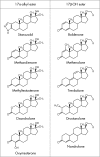Testosterone and doping control
- PMID: 16799097
- PMCID: PMC2657495
- DOI: 10.1136/bjsm.2006.027482
Testosterone and doping control
Abstract
Background and objectives: Anabolic steroids are synthetic derivatives of testosterone, modified to enhance its anabolic actions (promotion of protein synthesis and muscle growth). They have numerous side effects, and are on the International Olympic Committee's list of banned substances. Gas chromatography-mass spectrometry allows identification and characterisation of steroids and their metabolites in the urine but may not distinguish between pharmaceutical and natural testosterone. Indirect methods to detect doping include determination of the testosterone/epitestosterone glucuronide ratio with suitable cut-off values. Direct evidence may be obtained with a method based on the determination of the carbon isotope ratio of the urinary steroids. This paper aims to give an overview of the use of anabolic-androgenic steroids in sport and methods used in anti-doping laboratories for their detection in urine, with special emphasis on doping with testosterone.
Methods: Review of the recent literature of anabolic steroid testing, athletic use, and adverse effects of anabolic-androgenic steroids.
Results: Procedures used for detection of doping with endogenous steroids are outlined. The World Anti-Doping Agency provided a guide in August 2004 to ensure that laboratories can report, in a uniform way, the presence of abnormal profiles of urinary steroids resulting from the administration of testosterone or its precursors, androstenediol, androstenedione, dehydroepiandrosterone or a testosterone metabolite, dihydrotestosterone, or a masking agent, epitestosterone.
Conclusions: Technology developed for detection of testosterone in urine samples appears suitable when the substance has been administered intramuscularly. Oral administration leads to rapid pharmacokinetics, so urine samples need to be collected in the initial hours after intake. Thus there is a need to find specific biomarkers in urine or plasma to enable detection of long term oral administration of testosterone.
Conflict of interest statement
Competing interests: none declared
Similar articles
-
Ultra high performance liquid chromatography tandem mass spectrometry determination and profiling of prohibited steroids in human biological matrices. A review.J Chromatogr B Analyt Technol Biomed Life Sci. 2013 May 15;927:22-36. doi: 10.1016/j.jchromb.2012.12.003. Epub 2012 Dec 20. J Chromatogr B Analyt Technol Biomed Life Sci. 2013. PMID: 23317577 Review.
-
Searching for new markers of endogenous steroid administration in athletes: "looking outside the metabolic box".Forensic Sci Int. 2004 Jul 16;143(2-3):103-14. doi: 10.1016/j.forsciint.2004.02.031. Forensic Sci Int. 2004. PMID: 15240029
-
A pilot study on subject-based comprehensive steroid profiling: novel biomarkers to detect testosterone misuse in sports.Clin Endocrinol (Oxf). 2011 Jul;75(1):134-40. doi: 10.1111/j.1365-2265.2011.03992.x. Clin Endocrinol (Oxf). 2011. PMID: 21521264
-
A steroidomic approach for biomarkers discovery in doping control.Forensic Sci Int. 2011 Dec 10;213(1-3):85-94. doi: 10.1016/j.forsciint.2011.07.023. Epub 2011 Aug 9. Forensic Sci Int. 2011. PMID: 21831550
-
Metabolism and excretion of anabolic steroids in doping control--new steroids and new insights.J Steroid Biochem Mol Biol. 2006 Nov;101(4-5):161-78. doi: 10.1016/j.jsbmb.2006.06.024. Epub 2006 Sep 26. J Steroid Biochem Mol Biol. 2006. PMID: 17000101 Review.
Cited by
-
Realising the Potential of Urine and Saliva as Diagnostic Tools in Sport and Exercise Medicine.Sports Med. 2017 Jan;47(1):11-31. doi: 10.1007/s40279-016-0558-1. Sports Med. 2017. PMID: 27294353 Review.
-
Judging cheaters: is substance misuse viewed similarly in the athletic and academic domains?Psychol Addict Behav. 2012 Sep;26(3):678-82. doi: 10.1037/a0027872. Epub 2012 Apr 30. Psychol Addict Behav. 2012. PMID: 22545584 Free PMC article.
-
Circulating microRNA-122 as Potential Biomarker for Detection of Testosterone Abuse.PLoS One. 2016 May 12;11(5):e0155248. doi: 10.1371/journal.pone.0155248. eCollection 2016. PLoS One. 2016. PMID: 27171140 Free PMC article. Clinical Trial.
-
Detection of testosterone administration based on the carbon isotope ratio profiling of endogenous steroids: international reference populations of professional soccer players.Br J Sports Med. 2009 Dec;43(13):1041-4. doi: 10.1136/bjsm.2009.058669. Epub 2009 Jun 22. Br J Sports Med. 2009. PMID: 19549614 Free PMC article.
-
Sex Differences in Athletic Performance: Perspectives on Transgender Athletes.Exerc Sport Sci Rev. 2023 Jul 1;51(3):85-95. doi: 10.1249/JES.0000000000000317. Epub 2023 Apr 14. Exerc Sport Sci Rev. 2023. PMID: 37057897 Free PMC article.
References
-
- Milgrom E. Steroid hormones. In: Baulieu E‐E, Kelly PA, eds. Hormones: From Molecules to Disease. Paris: Hermann, 1990385–442.
-
- Wilson J D, Griffin J E. The use and misuse of androgens. Metabolism 1980291278–1295. - PubMed
Publication types
MeSH terms
Substances
LinkOut - more resources
Full Text Sources
Medical


